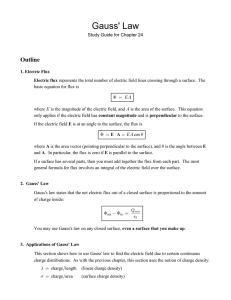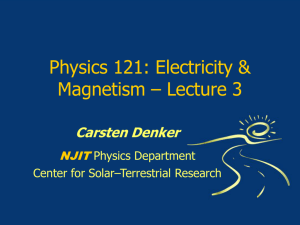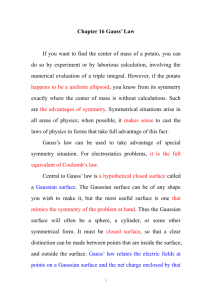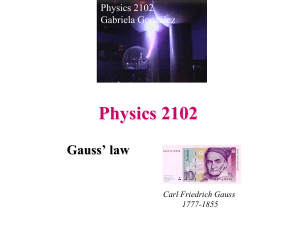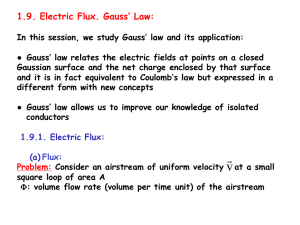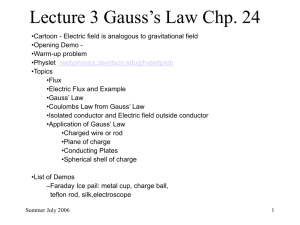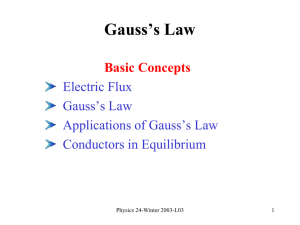Gauss' Law: Electric Flux and Applications
advertisement
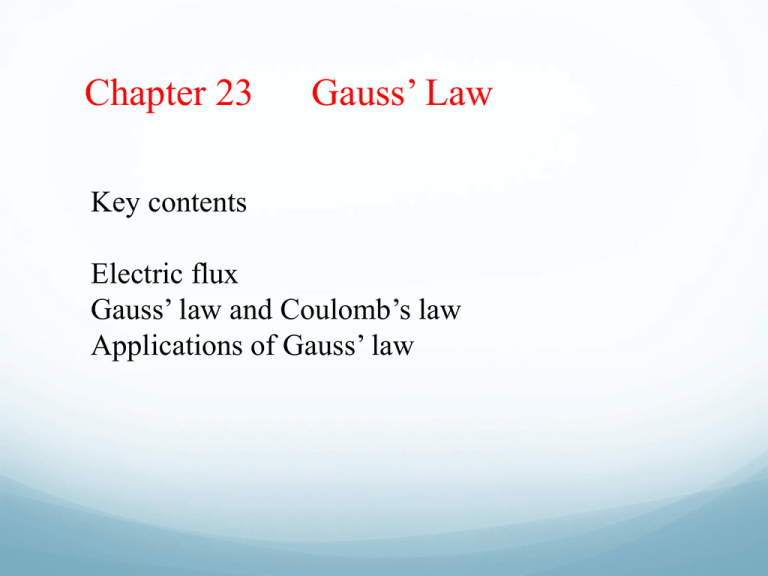
Chapter 23 Gauss’ Law Key contents Electric flux Gauss’ law and Coulomb’s law Applications of Gauss’ law 23.1 What is Physics?: Gauss’ law relates the electric fields at points on a (closed) Gaussian surface to the net charge enclosed by that surface. # Consider the flux passing through a closed surface and the amount of charge inside. 23.2: Flux Fig. 23-2 (a) A uniform airstream of velocity is perpendicular to the plane of a square loop of area A. (b) The component of perpendicular to the plane of the loop is v cos q, where q is the angle between v and a normal to the plane. (c) The area vector A is perpendicular to the plane of the loop and makes an angle q with v. (d) The velocity field intercepted by the area of the loop. The rate of volume flow through the loop is F= (v cos q)A. This rate of flow through an area is an example of a flux—a volume flux in this situation. # The actual physical quantity referred to by the term ‘flux’ can be different in different occasions. 23.3: Electric Flux The electric flux through a surface is defined to be the inner product of the electric field and the surface vector: FE = E ·DA For a closed surface, it is Example, Flux through a closed cylinder, uniform field: Example, Flux through a closed cube, Non-uniform field: Right face: An area vector A is always perpendicular to its surface and always points away from the interior of a Gaussian surface. Thus, the vector for any area element dA (small section) on the right face of the cube must point in the positive direction of the x axis. The most convenient way to express the vector is in unit-vector notation, Although x is certainly a variable as we move left to right across the figure, because the right face is perpendicular to the x axis, every point on the face has the same x coordinate. (The y and z coordinates do not matter in our integral.) Thus, we have Example, Flux through a closed cube, Non-uniform field: 23.4 Gauss’ Law: The net charge qenc is the algebraic sum of all the enclosed positive and negative charges, and it can be positive, negative, or zero. The electric field at the surface is due to all the charge distribution, including both that inside and outside the surface. 23.5 Gauss’ Law and Coulomb’s Law: One may also derive Gauss’ law from Coulomb’s law. These two laws are equivalent. ò V · da = ò (Ñ ·V )dt (Gauss theorem in vector analysis) ¶Vx ¶Vy ¶Vz Ñ ·V = + + ¶x ¶y ¶z ¶ ¶ ¶ Ñ º xˆ + yˆ + zˆ ¶x ¶y ¶z e0 ò (Ñ· E)dt = qenc r Ñ·E = e0 (Gauss’ law in differential form) Example, Relating the net enclosed charge and the net flux: Example, Enclosed charge in a non-uniform field: 23.6 A Charged Isolated Conductor: If an excess charge is placed on an isolated conductor, that amount of charge will move entirely to the surface of the conductor. None of the excess charge will be found within the body of the conductor. Figure 23-9a shows, in cross section, an isolated lump of copper hanging from an insulating thread and having an excess charge q. The Gaussian surface is placed just inside the actual surface of the conductor. The electric field inside this conductor must be zero. Since the excess charge is not inside the Gaussian surface, it must be outside that surface, which means it must lie on the actual surface of the conductor. Figure 23-9b shows the same hanging conductor, but now with a cavity that is totally within the conductor. A Gaussian surface is drawn surrounding the cavity, close to its surface but inside the conducting body. Inside the conductor, there can be no flux through this new Gaussian surface. Therefore, there is no net charge on the cavity walls; all the excess charge remains on the outer surface of the conductor. 23.6 A Charged Isolated Conductor; The External Electric Field: is the charge per unit area. qenc is equal to A. Example, Spherical Metal Shell, Electric Field, and Enclosed Charge: 23.7 Applying Gauss’ Law and Cylindrical Symmetry: Example, Gauss’ Law and an upward streamer in a lightning storm: 23.8 Applying Gauss’ Law, Planar Symmetry Non-conducting Sheet: 23.8 Applying Gauss’ Law, Planar Symmetry Two Conducting Plates: Example, Electric Field: 23.9 Applying Gauss’ Law, Spherical Symmetry: Fig. 23-19 The dots represent a spherically symmetric distribution of charge of radius R, whose volume charge density r is a function only of distance from the center. The charged object is not a conductor, and therefore the charge is assumed to be fixed in position. A concentric spherical Gaussian surface with r >R is shown. # Recall the case for gravitation. Homework: Problems 12, 20, 29, 39, 54

